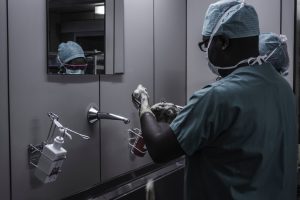
25 May Ignaz Semmelweis, our everyday hero
In recent weeks, we have again noticed in particular that hygiene regulations play an important role in the spread of diseases. Suddenly, the media are reporting on how to wash hands properly and that it is best to cough into the elbow so that pathogens are not spread via the hands. But especially in the medical field, hygiene rules were indispensable even before COVID-19. Particularly before and during an operation, meticulous care is taken to ensure that everything is as sterile as possible so that disease-causing germs do not enter the body. Clothes are changed, hoods, face masks and gloves are worn, and hands are thoroughly washed and disinfected before the operation.

But this exemplary behavior was not always on the agenda of medical staff, because hygiene did not play a major role in hospitals for a long time. The fact that additional hygiene measures took up some time meant that doctors often saw them as superfluous. They preferred to use them for the treatment of their patients. It was not until the Hungarian physician Ignaz Phillipp Semmelweis (1818-1865) that the importance of antiseptic prophylaxis was discussed. With his research, he laid the foundation for the fact that today we naturally pay attention to hygiene in everyday life.
Dr. Semmelweis got on the right track in the 1840s, when puerperal fever was claiming the lives of up to 30% of women1 who gave birth in hospitals. During this time, he worked in the maternity ward of the Vienna General Hospital, which was divided into two parts in 1833. In the first clinic male doctors and medical students worked, who took care of the birth of the mothers, in the second clinic female midwives were responsible for it. However, in the clinic where the doctors worked, three times as many mothers2 died as in the midwives’ clinic.
Ignaz Semmelweis wanted to understand how these serious differences came about and began to study the disease more closely. He noticed that women in the first clinic almost always became ill if they were in labor for much longer than 24 hours.1 This was not the case in the second clinic. In addition, he discovered, the risk of getting sick in women who gave birth on the street was significantly lower than in those who gave birth in the hospital.3
At the hospital, morning autopsies were also on the agenda before doctors and medical students entered the clinic. When a colleague died from a wound made during an autopsy and had previously exhibited the same symptoms as the patients who died of puerperal fever, Semmelweis recognized the connection: because examinations of expectant mothers were performed with bare hands following the morning autopsies, he hypothesized that particles found on the autopsy knife could later enter the uterus during an examination by a physician with contaminated hands.
His investigations suddenly made sense. Only male doctors and medical students were allowed to perform autopsies. Midwives, on the other hand, were not allowed in the morgues as women. As a result, only female patients in the medical clinic could come into contact with the pathogens. If several women were examined, more suddenly became ill at the same time. The hypothesis also made it clear why the risk of contracting puerperal fever was particularly high in women who had been in labor for more than 24 hours: they had to be examined several times, which increased the likelihood of infection. Women who gave birth in the street were not exposed to the contaminated hands of physicians.
In order to reduce the mortality rate again, Ignaz Semmelweis developed a chlorinated lime solution that was applied to the slopes before each examination to remove the germs on the surface of the hands. At a later stage, additional cleaning of the instruments was introduced. After the introduction of the chlorinated lime solution for cleaning the hands, the mortality rate in the doctors’ clinic dropped from 11.4% (1846) to 1.3% (1848).3

Despite the enormous successes, Ignaz Semmelweis did not receive recognition. In 1850, he left Vienna and took a position at the Szent Rókus (St. Rochus) Hospital in Pest, where his hand washing and sterilization techniques reduced maternal mortality to 0.85%.3 In 1855, he was appointed professor of obstetrics at the University of Pest.
Today, it is hard to imagine medicine without hygiene behavior. Hand hygiene is mandatory before and after every patient contact. Based on current knowledge of pathogen transmission via the hands, the World Health Organization (WHO) has established the 5 indication groups (“five moments”)4 as a basis for hand disinfection education and training. This involves disinfecting hands before patient contact, before aseptic activities, after contact with potentially infectious material, after patient contact, and after contact with the immediate patient environment. This regulation is designed to protect patients and medical staff from the transmission of pathogenic germs.
Did you know that 30% of hospital-acquired infections5 can be prevented through these strict hygiene regulations and the careful organization of hospital procedures? This is because the risk of coming into contact with infectious agents is particularly high in institutions where healthcare professionals care for patients. Thanks to Semmelweis’ discoveries, medicine has become more advanced, and that is why he is still the hero who frees us from the risk of infection in everyday life.
SOURCES
1 https://wwwnc.cdc.gov/eid/article/7/2/ac-0702_article
2 https://www.aerzteblatt.de/archiv/89995/Ignaz-Philipp-Semmelweis-Retter-der-Muetter
3 Carson, E.A.; Toodayan, N: Ignaz philipp semmelweis (1818-1865): Herald of hygienic medicine. Medical Journal of Australia, 10 December 2018, Vol.209(11), pp.480-482
5 https://www.lgl.bayern.de/gesundheit/hygiene/hygiene_medizinische_einrichtungen/index.htm
